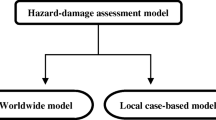Abstract
The article is developing an approach to creation of the automatic system for prediction of earthquakes. The technology of automatic prediction of earthquakes and its implementation in the form of a web-based GIS platform are considered. The platform represents any data on the stationary and dynamic properties of the seismic process in the form of spatial and spatio-temporal grid fields of features. This provides the possibility of joined processing of all available information. The forecast field is a function of the feature fields. A new machine learning method is proposed. The results on earthquake prediction method testing in the regions of the Mediterranean and Japan are presented.
The model and method of minimum area of alarm (Sect. 2) were developed with the financial support of the Russian Science Foundation, project No14-50-00150, development of technology and forecast platform, and testing (Sects. 3 and 4) were implemented with the financial support of the Russian Foundation for Basic Research, projects No17-07-00494 and No16-07-00326.
Access this chapter
Tax calculation will be finalised at checkout
Purchases are for personal use only
Similar content being viewed by others
References
Sobolev, G.A.: Principles of earthquake prediction (1993). (in Russian)
Sobolev, G.A., Ponomarev, A.V.: Earthquake physics and precursors (2003). (in Russian)
Keilis-Borok, V., Soloviev, A.A. (eds.): Nonlinear Dynamics of the Lithosphere and Earthquake Prediction, p. 337. Springer, Heidelberg (2013). https://doi.org/10.1007/978-3-662-05298-3
Zavyalov, A.D.: The intermediate term forecast of earthquakes: bases, technique, realization. Science (2006). (in Russian)
Shebalin, P.N., Narteau, C., Zechar, J.D., Holschneider, M.: Combining earthquake forecasts using differential probability gains. Earth Planets Space 66(1), 1–14 (2014)
Amei, A., Fu, W., Ho, C.H.: Time series analysis for predicting the occurrences of large scale earthquakes. Int. J. Appl. Sci. Technol. 2(7) (2012)
Gitis, V.G., Derendyaev, A.B.: An approach to the automatic prediction of earthquakes. J. Commun. Technol. Electron. 61(12), 1466–1473 (2016)
Gitis, V., Derendyaev, A., Weinstock, A.: Web-based GIS technologies for monitoring and analysis of spatio-temporal processes. Int. J. Web Inf. Syst. 12(1), 102–124 (2016)
Gitis, V.G., Derendyaev, A.B., Pertrov, K.N., Weinstock, A.P., Dumanskaya, I.O., Zatsepa, S.N., Zelenko, A.A., Ivchenko, A.A., Nesterov, E.S.: Technology of monitoring and analysis of the hydrometeorological situation in the Arctic. Inf. Process. 17(4), 261–283 (2017). (in Russian)
Dangermond, J.: Geodesign and GIS – designing our futures. In: Peer Reviewed Proceedings of Digital Landscape Architecture, Anhalt University of Applied Science, Germany (2010)
Harder, C.: The ArcGIS Book: 10 Big Ideas about Applying Geography to Your World. Esri Press, Redlands (2015)
Kotsiantis, S.B., Zaharakis, I., Pintelas, P.: Supervised machine learning: a review of classification techniques. In: Emerging Artificial Intelligence Applications in Computer Engineering, vol. 160, pp. 3–24 (2007)
Khan, S.S., Madden, M.G.: A survey of recent trends in one class classification. In: Coyle, L., Freyne, J. (eds.) AICS 2009. LNCS (LNAI), vol. 6206, pp. 188–197. Springer, Heidelberg (2010). https://doi.org/10.1007/978-3-642-17080-5_21
Bishop, C.M.: Machine Learning and Pattern Recognition. Information Science and Statistics. Springer, Heidelberg (2006)
Kharkevich, A.A.: Noise Suppression. Nauka, Moscow (1965). (in Russian)
International Seismological Centre: On-line Bulletin, Thatcham, UK (2015) http://www.isc.ac.uk
Author information
Authors and Affiliations
Corresponding author
Editor information
Editors and Affiliations
Rights and permissions
Copyright information
© 2018 Springer International Publishing AG, part of Springer Nature
About this paper
Cite this paper
Gitis, V.G., Derendyaev, A.B. (2018). Web-Based GIS Platform for Automatic Prediction of Earthquakes. In: Gervasi, O., et al. Computational Science and Its Applications – ICCSA 2018. ICCSA 2018. Lecture Notes in Computer Science(), vol 10962. Springer, Cham. https://doi.org/10.1007/978-3-319-95168-3_18
Download citation
DOI: https://doi.org/10.1007/978-3-319-95168-3_18
Published:
Publisher Name: Springer, Cham
Print ISBN: 978-3-319-95167-6
Online ISBN: 978-3-319-95168-3
eBook Packages: Computer ScienceComputer Science (R0)




